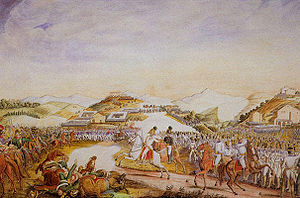Battle of Tolentino
| date | May 2, 1815 to May 3, 1815 |
|---|---|
| place | Tolentino |
| output | Withdrawal of the Neapolitans |
| Parties to the conflict | |
|---|---|
| Commander | |
| Troop strength | |
| 11,938 soldiers 1,452 horses 28 cannons |
25,588 soldiers 4,790 horses 58 cannons |
| losses | |
|
Total: 800 |
Total: 4,120 |
The Battle of Tolentino was between 2 and 3 May 1815 in the vicinity of Tolentino in the Italian region of Marche discharged. It was the decisive battle in the Austro-Neapolitan War between the Napoleonic Kingdom of Naples ruled by Joachim Murat and the Austrian Empire . The battle has some parallels to the Battle of Waterloo . Both took place during the reign of the Hundred Days after Napoleon's return from exile and ended in a decisive victory for the anti-Napoleonic coalition, resulting in a restoration of Bourbon rule .
background
At the end of April 1815, Joachim Murat was confronted with two advancing Austrian corps , one under the command of General Vinzenz Ferrerius von Bianchi , the other under the command of General Adam Albert von Neipperg , which were pushing the Neapolitans back towards Ancona . The two Austrian corps, however , had been separated by the Apennine Mountains , and Murat now hoped to be able to defeat Bianchi's corps first, before turning to von Neipperg, which was further west. His plan was thus similar to Napoleon's in Waterloo, who also wanted to defeat the British first and then the Prussians.
Murat planned to put Bianchi near the town of Tolentino. He left a small force under General Carrascosa to stop Neipperg and marched with his main force against Bianchi. However, an advance detachment of Hungarian hussars had already managed to overrun the small Neapolitan garrison of Tolentino on April 29th. Since an Austrian outpost was already established in Tolentino, Murat's army had to camp northeast of Macerata . Bianchi, in turn, recognized Murat's plans and decided to hold Murat off as long as possible. The Austrians built a defense line with the tower of San Catervo as the center and other troops in the key positions at Rancia Castle, the Church of Maestà and San Giuseppe. Murat was forced to attack, and so the two armies finally clashed on May 2nd.
battle
The battle began at dawn with artillery fire on both sides of the valley heading north to Sforzacosta . Although the Austrians had already lined up around Tolentino, Murat still managed to surprise them. Right from the start, Neapolitan troops succeeded in surrounding General Bianchi near Sforzacosta and taking him prisoner. However, shortly afterwards the general was freed by a regiment of Hungarian hussars. In the middle of the morning the Neapolitan army concentrated on the area around Pollenza , which led to fierce fighting there. During the course of the day, the Austrian position at Rancia Castle was at the center of the fighting and changed hands several times. At the end of the day, the Neapolitan army, despite its superiority and smaller territorial gains, including the Monte Milone, failed to drive the Austrians out of their good defensive positions.
On May 3, Nebel delayed the start of the battle until around 7:00 a.m. The day started well for Murat as the Neapolitan army finally managed to take the Rancia castle and the Cantagallo hills too. From these positions the Neapolitans launched further attacks on the Austrian positions. Two Neapolitan infantry divisions, one of them Murat's Guards Division, attacked the left flank of the Austrians from Monte Milone. However, the Neapolitans made the mistake of forming themselves in squares because they feared a cavalry counterattack, which did not take place. The Austrian infantry took these squares under heavy gunfire, supported by heavy artillery fire. In the meantime General Mohr had succeeded on the right flank in stopping the attacks by the Neapolitans, and so the entire Neapolitan army finally returned to Pollenza. The battle was still not decided and Murat received news that Neipperg had defeated General Carascosa's force at the Battle of Scapezzano and was approaching. In addition, he received the false news that the British fleet had landed a Sicilian army in southern Italy, which was now threatening his route of retreat. Little did Murat know, however, that the British fleet was actually on its way to block Naples and Ancona. Since defeat seemed inevitable, Murat decided to retreat and thus ended the battle. Murat went back to Naples, but with the Austrians approaching from land and the British from sea, Murat had no choice but to flee to Corsica disguised as a Danish sailor . The Battle of Tolentino was thus crucial, and already on May 20, which was the Treaty of Casa Lanza concluded with the Kingdom of the Two Sicily during the reign of Ferdinand I. built.
swell
- Capt. Batty, An Historical Sketch of the Campaign of 1815 , London (1820)
- Colletta, Pietro (translated by Horner, Susan). History of the Kingdom of Naples: 1734-1825 , Hamilton, Adams, and Co. (1858)
- Cust, Edward. Annals of the wars of the nineteenth century (1863)
Web links
- Tolentino 815 , the web site of the society which re-enacts and studies the battle.
- Battle of Tolentino at Napoleon Guide.
